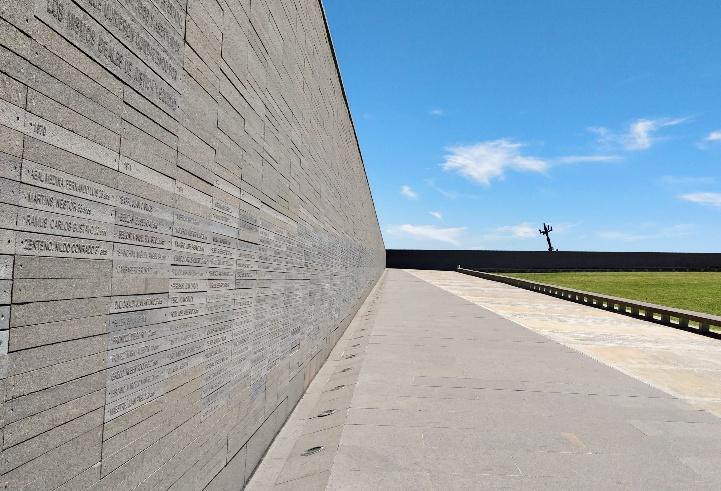¿Cómo crear una sola narrativa en un espacio donde las voces de 30.000 desaparecidos pueblan todavía las paredes quebradas? En la ex-ESMA, construyen una memoria colectiva que ilumina la violencia estatal que se escondió tras las escaleras. Al mostrar testimonios de los juicios, junto con textos informativos, tejen una narrativa oral y escrita mientras recorres esa misma historia con cada paso dado. En este momento, la ex-ESMA pone en relieve las experiencias de las mujeres en los centros clandestinos de detención como este, corrigiendo el discurso de los textos que las ocultan de las muestras para que la presencia de las sobrevivientes y las desaparecidas de la ex-ESMA sea visto. Hasta el lenguaje puede excluir las voces que queremos plantar en nuestra memoria colectiva, pero la muestra trabaja para evitar que se borren esas identidades. Termina la vista con una música triunfante, el sonido de la máquina de escribir, y la palabra repetida en todas las paredes: condenado. Una presentación de los juicios nacionales de lesa humanidad contra los culpables de la dictadura de 1976-1983 que siguen hoy en día. Un sentimiento de orgullo parece rellenar el espacio al ver cada retrato de militar u oficial desvanecer en los cuadros caídos al suelo. Un lugar de duelo y de reconocimiento con una historia reconstituida por fragmentos de una memoria colectiva. Suena las trompetas en la música final, aunque se oye todavía más fuerte la épica de lo que atravesaron los encapuchados.
How do you create one single narrative in a space where the voices of 30,000 disappeared peoples still live within the cracked walls? In the exESMA, they construct a collective history that sheds light on the state violence hidden behind the staircases. By combining judicial testimonies with informational text, they weave an oral and written account while you stand on that very history. At the moment, the exESMA is highlighting the experiences of the women in the clandestine centers of detention such as this one, editing the discourse used in the exhibition text so that the presence of the survivors and of the disappeared from the exESMA can still be seen. Even language can exclude and erase these voices from our collective memory, but the exhibit uses the power of inclusive discourse to preserve these identities. The visit closes with triumphant music, the sound of a typewriter, and the repeated word on the walls: “condenado” (convicted). A presentation of the national judicial trials against the military officials responsible for the dictatorship of 1976-1983; judicial proceedings which continue today. A feeling of pride seems to fill the room as the portraits of the military officials fade to black in the fallen frames on the ground. A place of mourning and recognition of a history is hereby reconstructed from the fragments of a collective memory. The trumpets blare in the final song, although the sound of the hardships of all the hooded detainees will always be the loudest.







Dejá un comentario